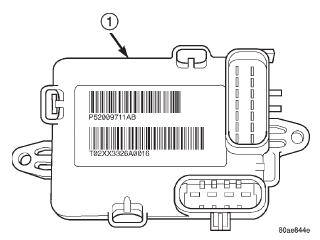Controller rear wheel antilock brakes. Rwal valve
DESCRIPTION The Controller Antilock Brakes (CAB) is a microprocessor
which handles testing, monitoring and controlling
the ABS brake system operation (Fig. 1). The
CAB functions are: NOTE: If the CAB needs to be replaced, the rear
axle type and tire revolutions per mile must be programed
into the new CAB. For axle type refer to
Group 3 Differential and Driveline. For tire revolutions
per mile refer to Group 22 Tire and Wheels. To
program the CAB refer to the Chassis Diagnostic
Manual.
1 - RWALCAB OPERATION SYSTEM SELF-TEST When the ignition switch is turned-on the microprocessor
RAM and ROM are tested. If an error
occurs during the test, a DTC will be set into the
RAM memory. However it is possible the DTC will
not be stored in memory if the error has occurred in
the RAM module were the DTC's are stored. Also it
is possible a DTC may not be stored if the error has
occurred in the ROM which signals the RAM to store
the DTC. CAB INPUTS The CAB continuously monitors the speed of the
differential ring gear by monitoring signals generated
by the rear wheel speed sensor. The CAB determines
a wheel locking tendency when it recognizes the ring
gear is decelerating too rapidly. The CAB monitors
the following inputs to determine when a wheel locking
tendency may exists: CAB OUTPUTS The CAB controls the following outputs for antilock
braking and brake warning information: DESCRIPTION The valve is located on the drivers side inner
fender under the hood. The valve modulates hydraulic
pressure to the rear brakes during an RWAL stop. OPERATION If the CAB senses that rear wheel speed deceleration
is excessive, it will energize an isolation solenoid
by providing battery voltage to the solenoid. This
prevents a further increase of driver induced brake
pressure to the rear wheels. If this initial action is
not enough to prevent rear wheel lock-up, the CAB
will momentarily energize a dump solenoid (the CAB
energizes the dump solenoid by providing battery
voltage to the solenoid). This opens the dump valve
to vent a small amount of isolated rear brake pressure
to an accumulator. The action of fluid moving to
the accumulator reduces the isolated brake pressure
at the wheel cylinders. The dump (pressure venting)
cycle is limited to very short time periods (milliseconds).
The CAB will pulse the dump valve until rear
wheel deceleration matches the desired slip rate programmed
into the CAB. The system will switch to
normal braking once wheel locking tendencies are no
longer present.
A predetermined maximum number of consecutive
dump cycles can be performed during any RWAL
stop. If excessive dump cycles occur, a DTC will be
set and stored in the CAB memory. If during a RWAL
stop, the driver releases the brake pedal, the reset
switch contacts will open. This signal to the CAB is
an indication that pressure has equalized across the
RWAL valve. The CAB will then reset the dump cycle
counter in anticipation of the next RWAL stop. Additionally,
any fluid stored in the accumulator will
force its way past the dump valve, back into the
hydraulic circuit and return to the master cylinder.
A fuse internal to the CAB, provides a fail-safe
device which prevents unwanted control over the isolation
and dump solenoids. The fuse is in series with
the isolation and dump solenoids output circuits. If
the internal fuse is open, the CAB cannot provide
voltage to energize either solenoid and RWAL stops
are prevented. If the fuse is open, the braking system
will operate normally but without antilock control
over rear brake pressure.Controller rear wheel antilock brakes
 Fig. 1 RWAL CAB
Fig. 1 RWAL CAB
Rwal valve
Dodge Durango (DN) 1998-2003 Service Manual
- Lubrication and Maintenance
- Suspension
- Differential and Driveline
- Brakes
- Cooling System
- Battery
- Starting Systems
- Charging System
- Ignition System
- Instrument Panel Systems
- Audio Systems
- Horn Systems
- Speed Control System
- Turn Signal and Hazard Warning Systems
- Wiper and Washer Systems
- Lamps
- Passive Restraint Systems
- Electrically Heated Systems
- Power Distribution System
- Power Lock Systems
- Vehicle Theft/Security Systems
- Power Seat System
- Power Window Systems
- Power Mirror Systems
- Chime/Buzzer Warning Systems
- Overhead Console Systems
- Engine
- Exhaust System
- Frame and Bumpers
- Fuel System
- Steering
- Transmission and Transfer Case
- Tires and Wheels
- Body
- Heating and Air Conditioning
- Emission Control Systems
- Introduction
